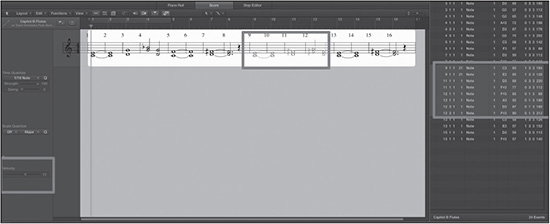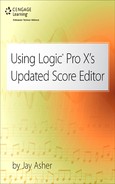4 Using the Score Editor’s New Local Inspector
FOR MANY LOGIC PRO X USERS, the new Local Inspector feature in the Score Editor will be very welcome indeed.
Take a look at Figure 4.1. Here you see a part in the Logic Pro 9 Score Editor with its Inspector open. Everything you set there pretty much affects the way things are displayed in the Score Editor, not the actual MIDI itself. Which is terrific, most of the time.
Figure 4.1 The Logic Pro 9 Score Editor with the Inspector.
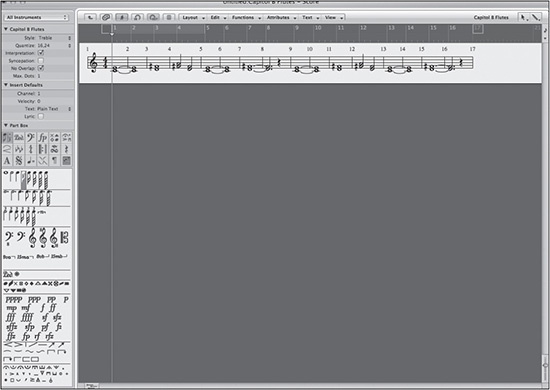
Source: Apple®.
And Figure 4.2 shows the part in the Logic Pro X Score Editor with the Inspector open. Sure, the color scheme is different and such, but basically this is the same old Inspector, which is mainly used for controlling display.
Figure 4.2 The Logic Pro X Score Editor with the Inspector.
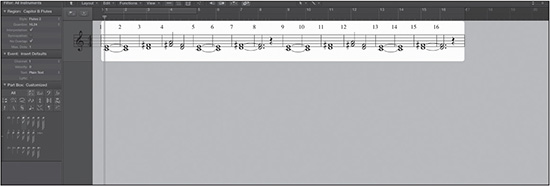
Source: Apple®.
In Logic Pro X in the Score Editor, it is now possible to perform some powerful MIDI manipulation without having to open another editor—this simply was not possible before. (This same functionality is also in the Piano Roll Editor. In the Logic Pro X built-in manual, it is under the section on that editor, where you see what ensues here explained.)
It is called the Local Inspector, and it is available only in Linear View. In Figure 4.3, I am enabling it, and in Figure 4.4 you can see the Local Inspector. (I have hidden the “normal” Inspector by pressing the i key.)
Figure 4.3 Enabling the Local Inspector.

Source: Apple®.
Figure 4.4 The Local Inspector.

Source: Apple®.
Figure 4.5 shows the Time Quantize area. You can select the notes in this region or select the whole region and set a value of your choice for it to quantize the notes to. But you don’t have to settle for “hard” Q or 100 percent quantizing. You can adjust the Strength percentage and even add a little Swing to it. Please remember that unlike the parameters in the “normal” Score Editor Inspector, these settings affect the actual MIDI notes and not just their display.
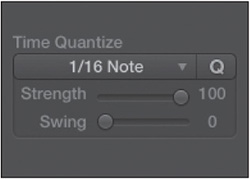
Source: Apple®.
Perhaps the most intriguing feature is the ability to quantize the pitch of the notes to scales (see Figure 4.6).

Source: Apple®.
In Figure 4.7, I am selecting some notes and scale quantizing to Eb Major.
Figure 4.7 Quantizing selected notes to Eb Major.

Source: Apple®.
And now, in Figure 4.8, you can see how the MIDI notes’ pitches, not just their displays, have changed. Very cool!
Figure 4.8 The notes’ pitches are changed to fit the Eb Major scale.

Source: Apple®.
Finally, we have the Velocity Slider, shown in Figure 4.9.
Figure 4.9 The Velocity Slider.

Source: Apple®.
In Figure 4.10, you can see that I have selected some notes in the Score Editor that are now highlighted in the Event List. Their velocities range from 65 to 72. What if you want their velocity to be higher?
Figure 4.10 The selected notes that you wish to increase the velocity of with the Velocity Slider.
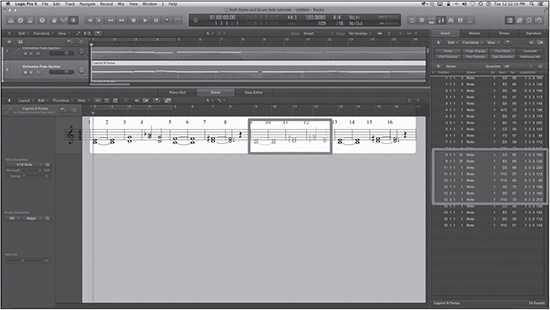
Source: Apple®.
No worries. With those notes still selected, you can drag the Velocity Slider up to 77. As you can see in Figure 4.11, they will then range from 77 to 92.
Figure 4.11 The previously selected notes now have higher velocities.
